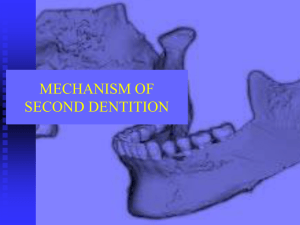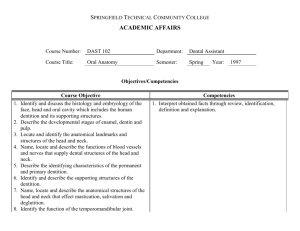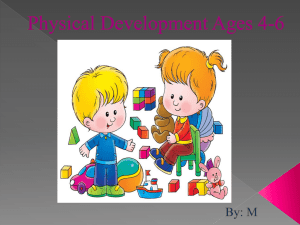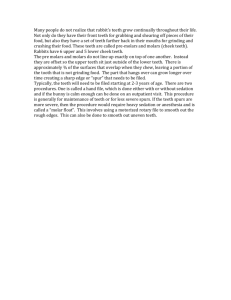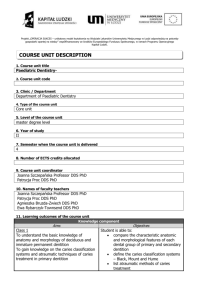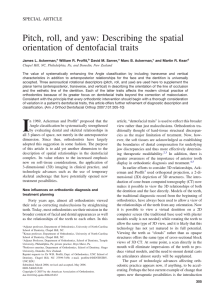Distal step
advertisement
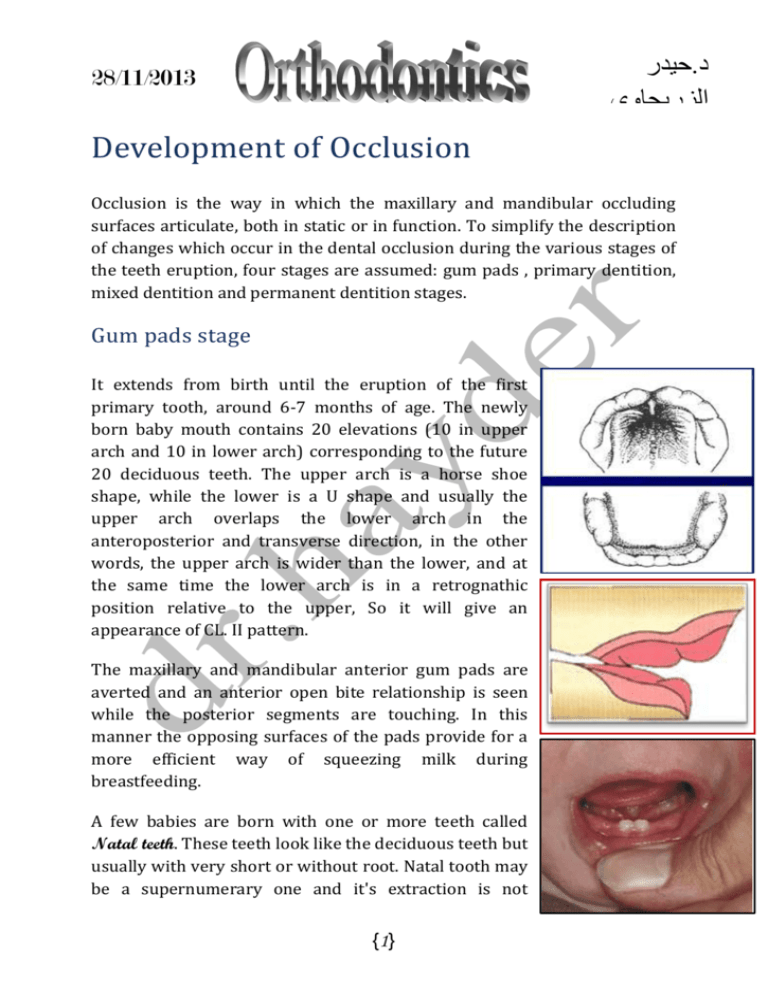
حيدر.د
الزريجاوي
28/11/2013
Development of Occlusion
Occlusion is the way in which the maxillary and mandibular occluding
surfaces articulate, both in static or in function. To simplify the description
of changes which occur in the dental occlusion during the various stages of
the teeth eruption, four stages are assumed: gum pads , primary dentition,
mixed dentition and permanent dentition stages.
Gum pads stage
It extends from birth until the eruption of the first
primary tooth, around 6-7 months of age. The newly
born baby mouth contains 20 elevations (10 in upper
arch and 10 in lower arch) corresponding to the future
20 deciduous teeth. The upper arch is a horse shoe
shape, while the lower is a U shape and usually the
upper arch overlaps the lower arch in the
anteroposterior and transverse direction, in the other
words, the upper arch is wider than the lower, and at
the same time the lower arch is in a retrognathic
position relative to the upper, So it will give an
appearance of CL. II pattern.
The maxillary and mandibular anterior gum pads are
averted and an anterior open bite relationship is seen
while the posterior segments are touching. In this
manner the opposing surfaces of the pads provide for a
more efficient way of squeezing milk during
breastfeeding.
A few babies are born with one or more teeth called
Natal teeth. These teeth look like the deciduous teeth but
usually with very short or without root. Natal tooth may
be a supernumerary one and it's extraction is not
{1}
Orthodontics ……………...……………….…….Development of Occlusion.
necessary unless it causes a painful situation for a breastfeeding mother.
Primary dentition stage
The primary dentition stage extends from the time of eruption of the
primary teeth until the eruption of the first permanent tooth around 6 years
of age, table (1). By 3 years of age, the eruption of deciduous teeth is usually
completed. The usual eruption sequence of deciduous teeth is A-B-D-C-E.
Table (1): Timing of calcification and eruption of primary dentition.
Primary tooth
Central incisors
Lateral incisors
Canines
1st molars
2nd molars
Calcification begins
( IU weeks)
12-16
13-16
15-18
14-17
16-23
Eruption
(months)
6-7
7-8
18-20
12-15
24-36
There are some characteristics can be seen in the primary dentition stage:
When these teeth erupt in the mouth, they will erupt
in a vertical dimension i.e. the upper long axes of the
central incisors coincide with the long axes of the
lower incisors, and usually there is slightly increase
in the Overjet.
The deciduous dentition usually erupt in spaced
condition. Spacing is normal throughout the
anterior part of the primary dentition but is most
noticeable
in
two
locations,
called
the
primate/anthropoid spaces. (Most subhuman
primates have these spaces throughout life, thus the
name). The primate spaces are located, mesial to the
upper canine and distal to the lower canine,
into which the opposing canine tooth interdigitates.
These spaces are normally present from the time the teeth erupt and
used for early mesial shift. Developmental spaces between the incisors
are often present from the beginning, but become somewhat larger as
{2}
Orthodontics ……………...……………….…….Development of Occlusion.
the child grows and the alveolar processes expand.
Spacing in the primary incisor region is normally
distributed among all the incisors, not just, in the
"primate space. This arrangement of the primary
incisor teeth with gaps between them may not be
very pretty, but it is normal. Adult appearing smile
in a primary dentition child is an abnormal, not a
normal finding—the spaces are necessary for
proper alignment of the permanent incisors.
The anteroposterior molar relationship in the primary dentition stage is
described in terms of the relationship between terminal planes. The
terminal planes are the distal surfaces of the maxillary and mandibular
second primary molars (E). Essentially the two terminal planes can be
related to each other in one of three ways:
A. Flush terminal plane relationship, both terminal planes of
maxillary and mandibular 2nd molars are at the same level
anteroposteriorly, it is the normal molar relation in primary
dentition because the mesiodistal width of the lower E is greater
than that of the upper E.
B. Distal step relationship, the mandibular molar terminal plane is
relatively distal to the maxillary molar terminal plane. Lastly,
C. Mesial step relationship, the mandibular molar terminal plane is
relatively mesial to the maxillary molar terminal plane.
{3}
Orthodontics ……………...……………….…….Development of Occlusion.
Determining the terminal plane relationships, in
the primary and mixed dentition stages, is of
great importance to the clinician because the
erupting first permanent molars are guided by
the distal surfaces of the second primary molars
as they erupt into occlusion.
When the deciduous second molars are in a
fIush terminal plane, the permanent first molar
erupts initially into a cusp-to-cusp relationship
In distal step occlusion, the permanent first
molar will be in a Class II relation when they
erupt. While in mesial step relationship, the
permanent first molar will erupt in Class I
relation in early mixed dentition.
Changes can occur in deciduous dentition:
By the effect of eruptive force of the permanent teeth, the resorption
occurs in the root of the deciduous teeth. Concurrently, at age of 5-6
years the occlusal force will be more, so these occlusal forces together
with root resorption will increase the mobility of the deciduous, which
facilitate the process of normal shedding.
Spaces try to increase with age due to growth of the jaw and attrition.
Since the shape of deciduous teeth is triangular, and these teeth will be
subjected to a great amount of wear at incisal edges and attrition of
proximal surfaces by mastication, a more spaces are produced between
them.
{4}
Orthodontics ……………...……………….…….Development of Occlusion.
:ملخصات
Summary
Normal features of gum pads stage:
1.
2.
3.
4.
5.
It's period is 6-7 months.
The mouth contains 20 elevations.
A horse shoe shape upper arch is wider than U- shaped lower arch.
Anterior open bite.
CL.II pattern.
Normal features of primary dentition stage:
1.
2.
3.
4.
Spacing ( primate & developmental).
Vertical inclination of the teeth with +O.J. and O.B.
The timing is variable but the sequence usually constant.
Flush terminal plane molars relation.
{5}
